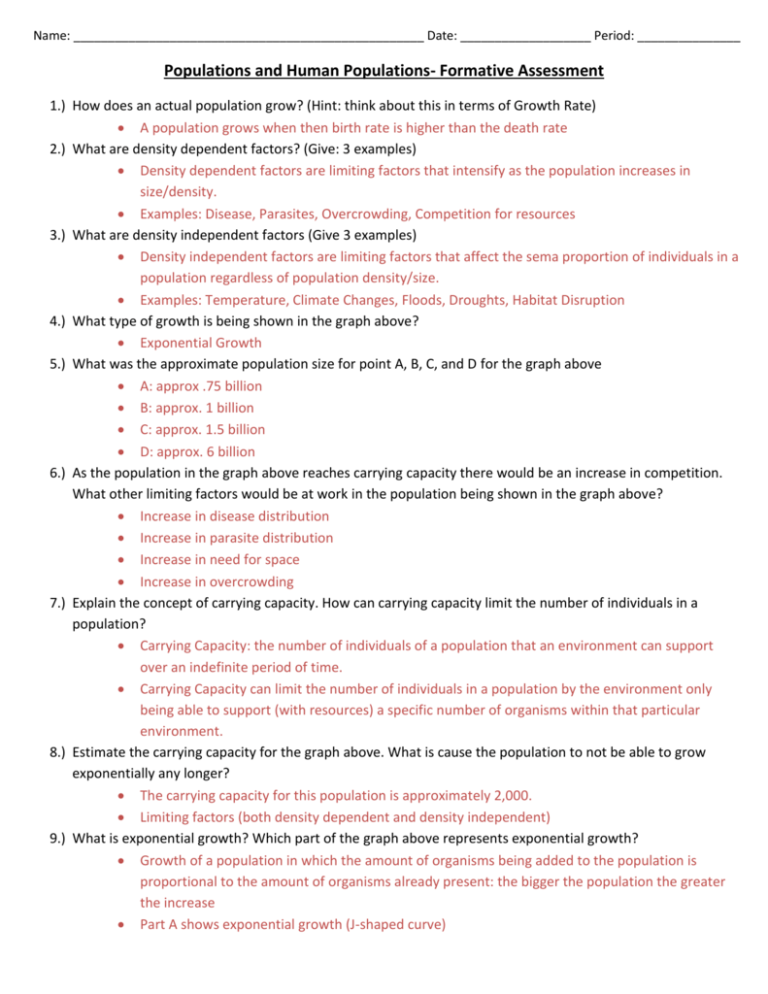Form Assess Pop and Human Pops Key
advertisement

Name: ___________________________________________________ Date: ___________________ Period: _______________ Populations and Human Populations- Formative Assessment 1.) How does an actual population grow? (Hint: think about this in terms of Growth Rate) A population grows when then birth rate is higher than the death rate 2.) What are density dependent factors? (Give: 3 examples) Density dependent factors are limiting factors that intensify as the population increases in size/density. Examples: Disease, Parasites, Overcrowding, Competition for resources 3.) What are density independent factors (Give 3 examples) Density independent factors are limiting factors that affect the sema proportion of individuals in a population regardless of population density/size. Examples: Temperature, Climate Changes, Floods, Droughts, Habitat Disruption 4.) What type of growth is being shown in the graph above? Exponential Growth 5.) What was the approximate population size for point A, B, C, and D for the graph above A: approx .75 billion B: approx. 1 billion C: approx. 1.5 billion D: approx. 6 billion 6.) As the population in the graph above reaches carrying capacity there would be an increase in competition. What other limiting factors would be at work in the population being shown in the graph above? Increase in disease distribution Increase in parasite distribution Increase in need for space Increase in overcrowding 7.) Explain the concept of carrying capacity. How can carrying capacity limit the number of individuals in a population? Carrying Capacity: the number of individuals of a population that an environment can support over an indefinite period of time. Carrying Capacity can limit the number of individuals in a population by the environment only being able to support (with resources) a specific number of organisms within that particular environment. 8.) Estimate the carrying capacity for the graph above. What is cause the population to not be able to grow exponentially any longer? The carrying capacity for this population is approximately 2,000. Limiting factors (both density dependent and density independent) 9.) What is exponential growth? Which part of the graph above represents exponential growth? Growth of a population in which the amount of organisms being added to the population is proportional to the amount of organisms already present: the bigger the population the greater the increase Part A shows exponential growth (J-shaped curve) 10.) How do climate changes have an effect on population growth? Harsh climates= can cause population declines Optimal climates = can cause population increases 11.) How might humans have an effect on an ecosystem’s carrying capacity? (Both positively or negatively) Humans may negatively effect an ecosystem’s carrying capacity through: o Deforestation: eliminating food and shelter for organisms o Industrialization: eliminating the ecosystem all together, causing organisms to migrate to other locations o Pollution: causing less clean water for consumption o Etc. Humans may positively effect an ecosystem’s carrying capacity through: o Conservational Efforts: conserving lands to maintain the stability of the ecosystem o Introduction/removal of a species: reintroducing/removing native species to maintain the ecosystems stability. o Etc. 12.) For the graph above, explain for sections A, B, C, and D the population growth in terms of birth rate and death rate. A: growth rate is slightly higher than death rate=slight population growth B: growth rate is much larger than death rate= large population growth C: growth rate is equal to death rate= no population growth D: Growth rate is less than death rate= declining pop. growth 13.) Explain how a change in habitat of one species affects the entire ecosystem (Hint: think invasive species). A change in habitat may disrupt the interaction of the organisms in the ecosystem. The drastic changes in the factors of a habitat that affect one species can in turn affect all species in that particular ecosystem. This is because all organisms of an ecosystem are connected in a cycling of nutrients (through food chains and food webs). This change could result in an organisms becoming endangered or extinct from a particular population. 14.) Explain the current pattern of human population growth. What are some concerns about this population growth, and what factors may limit growth in the future? Be specific and be sure you answer all parts of the question. As of now, the human population is growing exponentially. Some concerns about this growth include the lack of food, medication, and health care for our country as well as other less fortunate countries. Some factors that may limit growth include; o Less space available for growth of food and populations o Less medication able to be provided for the entire world (may not be manufactured quickly enough or may not have the means to manufacture) o Healthcare









